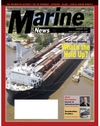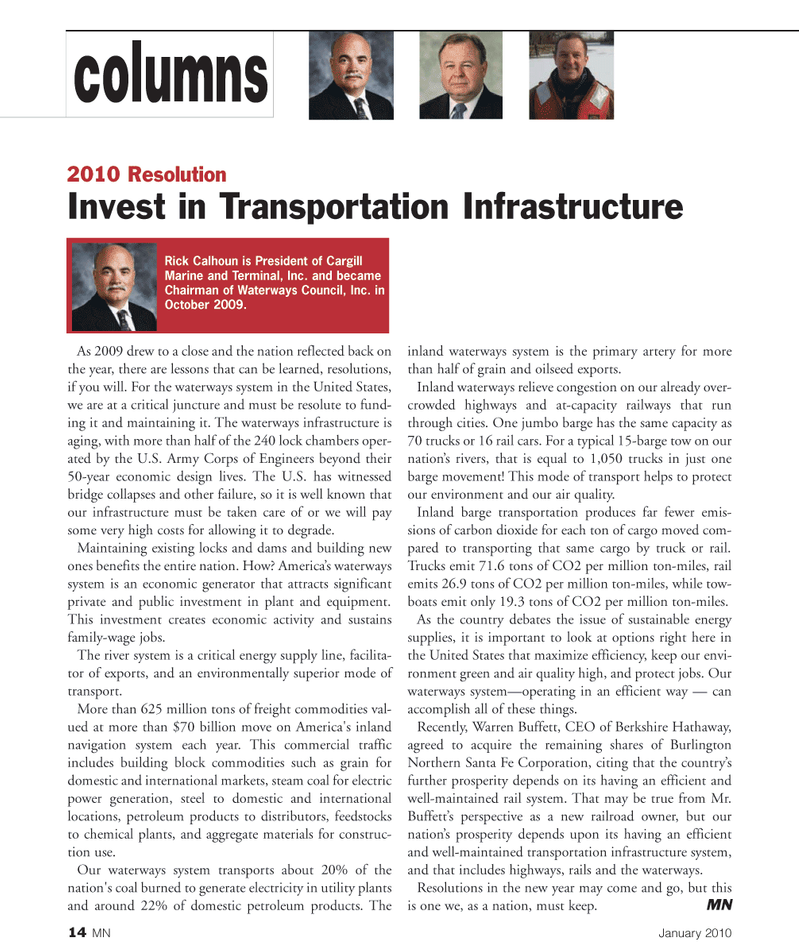
Page 14: of Marine News Magazine (January 2, 2010)
Read this page in Pdf, Flash or Html5 edition of January 2, 2010 Marine News Magazine
14 MN January 2010
As 2009 drew to a close and the nation reflected back on the year, there are lessons that can be learned, resolutions, if you will. For the waterways system in the United States, we are at a critical juncture and must be resolute to fund- ing it and maintaining it. The waterways infrastructure is aging, with more than half of the 240 lock chambers oper- ated by the U.S. Army Corps of Engineers beyond their 50-year economic design lives. The U.S. has witnessed bridge collapses and other failure, so it is well known that our infrastructure must be taken care of or we will pay some very high costs for allowing it to degrade.
Maintaining existing locks and dams and building new ones benefits the entire nation. How? America’s waterways system is an economic generator that attracts significant private and public investment in plant and equipment.
This investment creates economic activity and sustains family-wage jobs.
The river system is a critical energy supply line, facilita- tor of exports, and an environmentally superior mode of transport.
More than 625 million tons of freight commodities val- ued at more than $70 billion move on America's inland navigation system each year. This commercial traffic includes building block commodities such as grain for domestic and international markets, steam coal for electric power generation, steel to domestic and international locations, petroleum products to distributors, feedstocks to chemical plants, and aggregate materials for construc- tion use.
Our waterways system transports about 20% of the nation's coal burned to generate electricity in utility plants and around 22% of domestic petroleum products. The inland waterways system is the primary artery for more than half of grain and oilseed exports.
Inland waterways relieve congestion on our already over- crowded highways and at-capacity railways that run through cities. One jumbo barge has the same capacity as 70 trucks or 16 rail cars. For a typical 15-barge tow on our nation’s rivers, that is equal to 1,050 trucks in just one barge movement! This mode of transport helps to protect our environment and our air quality.
Inland barge transportation produces far fewer emis- sions of carbon dioxide for each ton of cargo moved com- pared to transporting that same cargo by truck or rail.
Trucks emit 71.6 tons of CO2 per million ton-miles, rail emits 26.9 tons of CO2 per million ton-miles, while tow- boats emit only 19.3 tons of CO2 per million ton-miles.
As the country debates the issue of sustainable energy supplies, it is important to look at options right here in the United States that maximize efficiency, keep our envi- ronment green and air quality high, and protect jobs. Our waterways system—operating in an efficient way — can accomplish all of these things.
Recently, Warren Buffett, CEO of Berkshire Hathaway, agreed to acquire the remaining shares of Burlington
Northern Santa Fe Corporation, citing that the country’s further prosperity depends on its having an efficient and well-maintained rail system. That may be true from Mr.
Buffett’s perspective as a new railroad owner, but our nation’s prosperity depends upon its having an efficient and well-maintained transportation infrastructure system, and that includes highways, rails and the waterways.
Resolutions in the new year may come and go, but this is one we, as a nation, must keep. MN 2010 Resolution
Invest in Transportation Infrastructure columns
Rick Calhoun is President of Cargill
Marine and Terminal, Inc. and became
Chairman of Waterways Council, Inc. in
October 2009.

 13
13

 15
15
